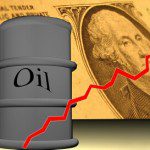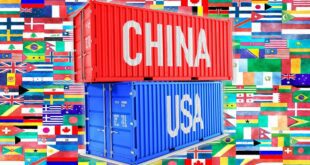With the Middle East now lurching towards yet another major war, it’s easy to envision a supply disruption that sends oil back to its previous high or beyond. So the question becomes, what would that do to today’s hyper-leveraged global economy? Bad things, obviously. Here are just 4 things that would likely happen.
sends oil back to its previous high or beyond. So the question becomes, what would that do to today’s hyper-leveraged global economy? Bad things, obviously. Here are just 4 things that would likely happen.
The above comments are edited excerpts from an article* by John Rubino (dollarcollapse.com) entitled We Are So Not Prepared For Another Oil Shock.
Rubino goes on to say in further edited excerpts:
So what would $150/bbl oil mean today? Several things:
1. Another recession
The U.S. economy contracted at an annual rate of about 2% in the first quarter and isn’t nearly as strong as analysts had predicted going forward. Let gas go to $5 a gallon, and the consumer spending on which the U.S. economic model depends would dry up. Put another way, we might spend the same amount but it will be mostly for gas and not much else. So much for the recovery.
2. Equity bear market
Stock prices depend on corporate profits, which in turn depend on sales. If Americans buy less, corporations earn less. With blue chip equities currently priced for perfection, major companies faced with a sales slowdown will, if they want to keep their stock prices from tanking, have to borrow even more money and buy back even more shares, which will only work until interest costs start consuming what’s left of their profits. Then US stocks fall hard.
3. Currency crisis
If Saudi Arabia manages to stay out of this latest conflict, it will see its revenues surge as it sells the same amount of oil at higher prices, but it’s not happy with the U.S. (something about us recently tilting towards Iran) and apparently no longer feels obligated to accept only dollars for its oil. Let it start accepting euros, yen and yuan, and the result will be lessened demand for dollars, a falling dollar exchange rate and all manner of turmoil in global bond markets.
4. Derivatives implosion
Derivatives — basically private bets on the behavior of interest rates, currency exchange rates and corporate bond defaults — on the books of major banks have actually increased in the five years since those instruments nearly destroyed the global financial system. There are between half a quadrillion and one quadrillion dollars face value of derivatives out there, and a spike in financial market volatility would cause a lot of them to blow up.
Conclusion
There are other possible consequences of a major Middle East war, but the preceding is enough to make the point that the more leveraged a system is, the more vulnerable it is to external shocks – and no one has ever been as leveraged as we are right now.
*http://dollarcollapse.com/the-economy/we-are-so-not-prepared-for-another-oil-shock/ (Copyright © DollarCollapse.com)
Related Articles:
1. Could a World of $7,000 Gold, $100 Silver & $400 Oil Be Coming?
Jim Rickards explains in his new book “The Death of Money – The Coming Collapse of the International Monetary System” why a US dollar collapse could be coming and why gold would probably emerge at the heart of a new global monetary system as the only money that you can really trust. Read More »
2. Invested in the S&P 500? Then Watch Price of WTI Crude Oil Closely – Here’s Why
For the past few years West Texas Intermediate Crude (WTIC) oil and the S&P 500 have trended together and have hit key highs and lows around the same time window. WTIC is now within 1% of the top of its multi-year pennant pattern which has brought on short-term S&P 500 corrections. What does that mean for the future direction of the S&P 500 this time round? Read More »
 munKNEE.com Your Key to Making Money
munKNEE.com Your Key to Making Money


